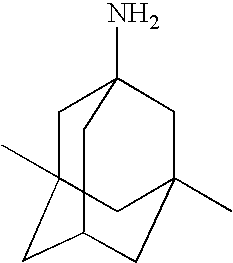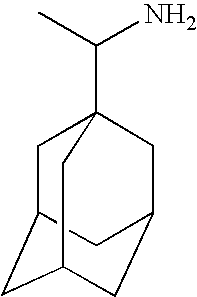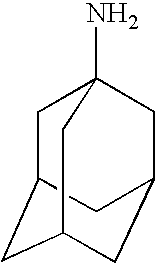Treatment of Demyelinating Conditions
a demyelinating condition and uncompetitive technology, applied in the direction of biocide, heterocyclic compound active ingredients, drug compositions, etc., can solve the problems of progressive neurological impairment, scarring and damage to the underlying nerve fibers, loss of electrical insulation, etc., and achieve the effect of reducing symptoms and reducing symptoms
- Summary
- Abstract
- Description
- Claims
- Application Information
AI Technical Summary
Benefits of technology
Problems solved by technology
Method used
Image
Examples
example 1
Memantine Trials
[0078]In this example, a series of comparative studies of memantine dosages for multiple sclerosis is described. The study is a multi-centre, double-blind, randomized, placebo-controlled efficacy study of various doses of memantine. The trial enrols 125 patients with MS at 6-10 sites. Study duration is 1 year.
[0079]Patients. Patients eligible for this study include IFN-naïve patients, between the ages of 18-55, diagnosed within the past 2 years with relapsing-remitting MS (RR-MS). Such patients will typically have evidence of demyelination on MRI scanning of the brain and have an Extended Disability Status Scale (EDSS) score between 0 and 3.5.
[0080]Study design. Treatment, Double-Blind, Efficacy Study.
[0081]Study assessments. The initial screening assessment includes a complete neurologic and medical history, physical and neurologic examination, including the extended disability status scale (EDSS), Ambulation Index (AI), disease steps (DS) scale MS functional compos...
example 2
Amantadine Trials
[0083]In this example, a series of comparative studies of memantine dosages for multiple sclerosis is described. The study is a multi-centre, double-blind, randomized, placebo-controlled efficacy study of various doses of memantine. The trial enrols 125 patients with MS at 6-10 sites. Study duration is 1 year.
[0084]Patients. Patients eligible for this study include IFN-naïve patients, between the ages of 18-55, diagnosed within the past 2 years with relapsing-remitting MS (RR-MS). Such patients will typically have evidence of demyelination on MRI scanning of the brain and have an Extended Disability Status Scale (EDSS) score between 0 and 3.5.
[0085]Study design. Treatment, Double-Blind, Efficacy Study.
[0086]Study assessments. The initial screening assessment includes a complete neurologic and medical history, physical and neurologic examination, including the extended disability status scale (EDSS), Ambulation Index (AI), disease steps (DS) scale MS functional compo...
example 3
Rimantadine Trials
[0088]In this example, a series of comparative studies of memantine dosages for multiple sclerosis is described. The study is a multi-centre, double-blind, randomized, placebo-controlled efficacy study of various doses of memantine. The trial enrols 125 patients with MS at 6-10 sites. Study duration is 1 year.
[0089]Patients. Patients eligible for this study include IFN-naïve patients, between the ages of 18-55, diagnosed within the past 2 years with relapsing-remitting MS (RR-MS). Such patients will typically have evidence of demyelination on MRI scanning of the brain and have an Extended Disability Status Scale (EDSS) score between 0 and 3.5.
[0090]Study design. Treatment, Double-Blind, Efficacy Study.
[0091]Study assessments. The initial screening assessment includes a complete neurologic and medical history, physical and neurologic examination, including the extended disability status scale (EDSS), Ambulation Index (AI), disease steps (DS) scale MS functional comp...
PUM
| Property | Measurement | Unit |
|---|---|---|
| electrical insulation | aaaaa | aaaaa |
| physical fatigue | aaaaa | aaaaa |
| emotional stress | aaaaa | aaaaa |
Abstract
Description
Claims
Application Information
 Login to View More
Login to View More - R&D
- Intellectual Property
- Life Sciences
- Materials
- Tech Scout
- Unparalleled Data Quality
- Higher Quality Content
- 60% Fewer Hallucinations
Browse by: Latest US Patents, China's latest patents, Technical Efficacy Thesaurus, Application Domain, Technology Topic, Popular Technical Reports.
© 2025 PatSnap. All rights reserved.Legal|Privacy policy|Modern Slavery Act Transparency Statement|Sitemap|About US| Contact US: help@patsnap.com



